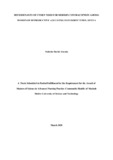| dc.description.abstract | Unmet need for modern contraception is one of the most vital indicators of birth control programs and policies. It is challenging to motivate women of childbearing age to adopt contemporary means of birth control especially in urban poor settings. The government of Kenya has instituted several strategies and policies to improve acceptance of family planning services in order to increase contraceptive prevalence rate (CPR) and reduce total fertility rate and unmet need which still remains high at 46 and 24 percent respectively. With poverty level of 49%, the incidence of unsafe abortion in informal settlements of Eldoret is on the rise from 23.6% in 2018 to 32% in 2019. The broad objective of this study was to analyze the determinants of unmet need for moderncontraception among women of reproductive age living in formal and informal settlements of Eldoret town. A community-basedsurvey was conducted in Langas informal settlement and Old Uganda Road Estates of Eldoret.527respondents (15 to 49) were interviewedfrom randomly selected households through multistage sampling method. Data collection tools used in this survey were,apre tested questionnaire, key informant interview and focus group discussion guides. The reliability test conducted using Cronbach’s alpha reported an internal consistency of 0.810 from the pilot results. The independent variables included age, marital status, level of education, occupation, residence, partner’s disapproval and fear of side effects among others. The dependent variable was unmet need. Descriptive statistics, bivariate and multiple logistic regressions were used in data analysis using SPSS version 19 software. Odds ratios with 95% confidence interval were calculated. P value of less than 0.05 was used to establish statisticalsignificance. Age, place of residence, partner’s level of education, employment, religion, fear of side effects, marital status, number of living children, husband disapproval, husband’sdecision on number of children, accessibility and never having been pregnant were significantly associated withunmet need for modern contraception. Overall, unmet need for limiting births was high among residents of Old Uganda road compared with Langas. On the contrary, unmet need for spacing childbirths was higher in Langas than Old Uganda road estate. The study recommended that FP service providers, CHV’s and community-basedorganizations give health education on benefits of contraceptive services, available methods in the market, usage and side effects of the methods inboth settlements. FP service providers and CHV’s in both settlements to counsel couples on FP method discussion to enhance approval. Increase number of FP service providers in Langas to ease overcrowding at service delivery points. Since men did not participate in this study, further research is recommended on men’s perspectives on reasons for non-use of birth control methods in formal and informal settlements of Eldoret. | en_US |

